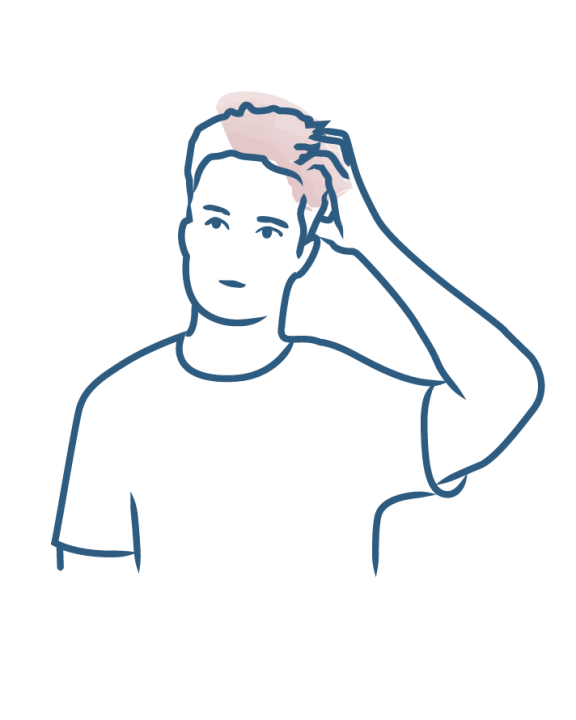Causes of itching: why do we scratch?
Iatrogenic pruritus or drug-induced pruritus

Iatrogenic pruritus or drug-induced pruritus
Drug-induced pruritus is a very specific form of pruritus, related to the use of one or more medications taken systemically. The molecules responsible for drug-induced pruritus are very varied, and sometimes difficult to identify, especially if the person is of fragile health and takes multiple medications. The physician's role is essential in the management of drug-induced pruritus, both in making the diagnosis and proposing a solution adapted to each patient.
Recognizing iatrogenic pruritus
Drug-induced pruritus is one of the types of pruritus sine materia. In other words, it is a pruritus of non-dermatological origin, and without skin lesions that can explain it.
Most often, iatrogenic pruritus is a generalized type of pruritus, present on the whole body. So, it is difficult to resist the urge to scratch, hence the possible appearance of scratching lesions (or prurigo).
Itching sensations may appear at the beginning of treatment or later, depending on the case. Drug-induced pruritus can develop even at low doses. It is favored by a set of factors common to all types of pruritus, such as skin dryness, climatic conditions, stress, the use of unsuitable cosmetics, etc.
What are the causes of drug-related pruritus?
As the name suggests, drug-related pruritus is caused by one or more medications taken systemically.
Many drug leaflets list itching and pruritus as a possible treatment-related side effect. These drugs belong to very different therapeutic classes, they are acute or chronic treatments depending on the case. Here are some examples of drugs that can cause iatrogenic pruritus:
- Antibiotics. Examples: tetracyclines, beta-lactams.
- Anti-hypertensives. Examples: enzyme conversion inhibitors, sartans.
- Heart medications. Examples: beta-blockers, amiodarone.
- Cholesterol medications. Examples: statins and fibrates.
- Analgesics. Examples: morphine and its derivatives, aspirin, non-steroidal anti-inflammatory drugs.
- Anti-epileptics. Examples: barbiturates, carbamazepine, sodium valproate.
- Antidepressants. Examples: tricyclic antidepressants.
- Others. Examples: allopurinol, iodinated contrast agents.
That being said, all medications can potentially be sources of iatrogenic pruritus. Remember to report any recent medications taken to your doctor, whether with or without a prescription. Why do we scratch? Medications can cause iatrogenic pruritus through a variety of mechanisms:
- Immunological: drug-induced pruritus appears in a context of immediate or delayed hypersensitivity.
- Pharmacological: drug-induced pruritus appears in a more indirect way, due to the different mechanisms of action of drugs. For example, a drug that causes dry skin can cause pruritus. The same applies to drugs that cause cholestasis or histamine release.
It should be noted that in some cases the onset mechanism of drug-induced pruritus is not known.
Relieving itching due to drug-induced pruritus
In the case of drug-induced pruritus, it is most often necessary to stop the treatment in order to confirm the diagnosis and to relieve the pruritus effectively, generally after several weeks of stopping. Do not stop treatment without your doctor’s approval, except in cases of very severe skin damage requiring immediate cessation of treatment.
An anti-histamine is sometimes prescribed in parallel with the treatment in cases of drug-induced pruritus. Appropriate dermo-cosmetic treatments such as a soothing cleansing oils and anti-itching creams help soothe the skin. Use anti-itching creams as often as necessary rather than scratching. Applying cold to the skin also helps to calm itching related to drug-induced pruritus: thermal spring water, the back of a spoon, a fan, a bag of frozen peas, etc.
To stop the itching, doctors can replace the drug responsible for the iatrogenic pruritus with another, but unfortunately this is not always possible. If the drug treatment is to be continued, a reduction in dosage is usually considered to maintain the effectiveness of the treatment while limiting adverse effects.
More information
- Discover Aquagenic Pruritus
Causes of itching: why do we scratch?
Aquagenic Pruritus
- Discover Senile Pruritus
Causes of itching: why do we scratch?
Senile Pruritus
- Discover Sun Allergy
Causes of itching: why do we scratch?
Sun Allergy
- Discover Dermatological Pruritus
Causes of itching: why do we scratch?
Dermatological Pruritus
- Discover Pruritus sine materia
Causes of itching: why do we scratch?
Pruritus sine materia
Our care routines
Itching on the scalp
Dermatological expertise
To better understand your skin and hair, discover our exclusive content and innovative care products designed to improve your quality of life..

